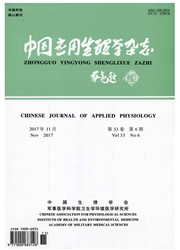

 中文摘要:
中文摘要:
目的:研究血红素代谢限速酶和珠蛋白代谢在运动性贫血发生机理中的功能和作用,及营养补充对运动性贫血防治效果的作用机制。方法:本实验对30只雄性Wistar大鼠进行等量随机分为3组(n=10):对照组(C)、运动组(P)和运动+营养组(G)。30m/min、0%坡度、每次1min为起始训练方式,前5周和后4周时训练时间的加速度为每次2min,训练频率为每天2次(前两周例外)。11周的跑台运动结束后应用RT-PCR和免疫组织化学的方法测试骨髓每氨基-γ酮戊酸合成酶(ALAs)、铁螯合酶(ferrochelatase)、α-珠蛋白、β-珠蛋白的基因表达和肝脏血红素氧舍酶-1(HO-1)的活性。结果:11周跑台运动可以增加大鼠肝脏HO-1的活性和骨髓β-珠蛋白的基因表达(P〈0.01,P〈0.05),抗运动性贫血复合剂补充并不能改变大鼠运动后血红素代谢限速酶和珠蛋白基因表达和活性,且运动+营养组大鼠肝脏HO-1活性水平显著高于对照组(P〈0.01),即递增负荷跑台运动不能影响大鼠骨髓血红素合成酶和α-珠蛋白的基因表达,但能够影响大鼠肝脏血红素分解酶的活性水平和骨髓β-珠蛋白的基因表达。结论:肝脏HO-1活性水平的升高可能是运动性贫血表现出低Hb、RBC和Hct水平的原因之一。
 英文摘要:
英文摘要:
Aim:To investigate the possible role of rate-limiting enzyme of heme metabolism and globin in the development of the low hemoglobin (Hb), rod blood(cell) count(RBC) and hematocrit(Hct) after long-term exercise, and effect of nutrition supplement on sports anemia. Methods: Male Wistar rats were randomly assigned to three groups( n = 10) : control(C), exercise(P) and exercise + nutrition(G). Animals in the P and G groups started treadmill nmning at 30 m/min, 0% grade, 1 min/time. Running time was gradually increased with 2 min/time during initial 5 weeks and final 4 weeks. In addition, running frequency was 2 times/day except initial 2 weeks. At the end of eleventh week, gene expression of 5-aminolevulinate synthase(ALAS), ferrochelatase, α-globin and β-globin in bone marrow were measured with RT-PCR. Meanwhile heme oxygenase 1(HO-1) activity in liver was measured with method. Results: Eleven weeks of exercise induced a significant increase in HO-1 and a significant increase in gene expression of β-globin( P 〈 0.01, P 〈 0.05, respectively). Treatment with anti-sports anemia compound dosage led to no significant differences in rate-limiting enzyme of heme metabolism and globin in the exercised rats. The G group had a significantly higher HO-1 level in liver than the C group ( P 〈 0.01). These finds showed that exercise was associated with no significant difference in heme synthetase and α-globin gene expression, and significant difference in heme catabolic enzyme and β-globin gene expression. Conclusion: The increase of HO- 1 activity in liver might be one of the causes of the lower Hb, RBC and Hct status in exercised rats.
 同期刊论文项目
同期刊论文项目
 同项目期刊论文
同项目期刊论文
 期刊信息
期刊信息
